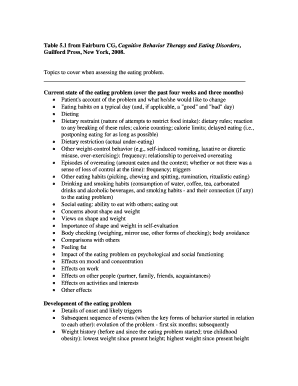Loading

Get Table 5.1 From Fairburn Cg, Cognitive Behavior Therapy And ...
How it works
-
Open form follow the instructions
-
Easily sign the form with your finger
-
Send filled & signed form or save
How to use or fill out the Table 5.1 from Fairburn CG, Cognitive Behavior Therapy And ... online
Filling out Table 5.1 from Fairburn CG provides essential insights into the eating problem and its influence on an individual’s life. This guide offers step-by-step instructions on how to complete the form accurately online, ensuring a comprehensive understanding of the eating behaviors and related factors.
Follow the steps to complete the Table 5.1 accurately online.
- Click the ‘Get Form’ button to access the form and open it in your preferred workspace.
- Begin by detailing the current state of the eating problem. Specify the patient's account of their eating habits over the past four weeks and three months, including the changes they desire.
- Document their typical eating habits for a regular day, and distinguish between what they consider a 'good' and 'bad' day in terms of eating.
- Record information about any dietary restraint. Indicate the nature of their attempts to restrict food intake, including specific dietary rules and their reactions to breaking these rules.
- Outline any actual under-eating behaviors under dietary restriction. This includes frequency and specifics regarding their eating patterns.
- Detail other weight-control behaviors such as self-induced vomiting, laxative misuse, and over-exercising. Include frequency and the perceived relationship to any overeating.
- Document episodes of overeating, including the amount eaten, context, and whether there was a sense of loss of control at that time.
- Note any unusual eating habits, such as picking, chewing and spitting, or ritualistic eating practices that may be relevant.
- Capture the user's drinking and smoking habits and note their potential connection to the eating problem.
- Include observations about social eating, particularly their ability to eat with others and their experiences dining out.
- Assess concerns regarding shape and weight. Note their views on these aspects and their importance in self-evaluation.
- Discuss body-checking behaviors, including weighing, mirror use, and any forms of body avoidance. Include feelings of fat and comparison with others.
- Explore the impact of the eating problem on psychological and social functioning, mood, concentration, work, relationships with others, and overall activities.
- Trace the development of the eating problem by detailing its onset, likely triggers, and the sequence of behavioral changes.
- Record weight history, noting the lowest and highest weights since the start of the eating problem.
- Summarize any prior treatments for eating or weight problems, including treatment-seeking behavior and response to past treatments.
- Provide personal and family history, including upbringing, family dynamics, interpersonal relationships, and any significant adverse events.
- Document current circumstances and functioning, including living arrangements, occupation, and interpersonal relationships.
- Assess for co-existing psychological conditions, current treatments, and their effectiveness.
- Evaluate the user's current physical health, including any relevant medical history and medication.
- Conclude with the user's attitudes towards their eating problem and treatment, including their goals and concerns about change.
- Finally, ensure to include any additional information or thoughts the user may have that is pertinent to the assessment.
- Once all fields are completed, save the changes, and utilize options to download, print, or share the final document as needed.
Start filling out your document online today for a thorough assessment of your eating behaviors.
CBT-E is the abbreviation for “enhanced cognitive behaviour therapy”, and is one of the most effective treatments for eating disorders. It is a “transdiagnostic” treatment for all forms of eating disorder including anorexia nervosa, bulimia nervosa, binge eating disorder and other similar states.
Industry-leading security and compliance
US Legal Forms protects your data by complying with industry-specific security standards.
-
In businnes since 199725+ years providing professional legal documents.
-
Accredited businessGuarantees that a business meets BBB accreditation standards in the US and Canada.
-
Secured by BraintreeValidated Level 1 PCI DSS compliant payment gateway that accepts most major credit and debit card brands from across the globe.


